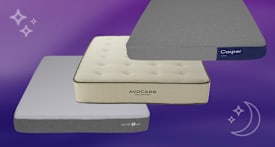How to Choose a Diaper Rash Cream Without Harmful Chemicals
We tell you which products are effective and safe, plus share tips on ingredients to avoid

Diaper cream is a nursery essential that parents reach for over and over. That’s why it’s critical that it’s safe for babies, parents, and the planet. To help you shop, we looked into some concerns about diaper cream and how to spot better options, and we can offer some top choices.
CR partnered with Made Safe, an independent organization that screens household products for potentially harmful ingredients and certifies those superior for human and ecosystem health. Made Safe scrutinized the ingredients lists of 14 diaper creams. The results below identify products with the fewest chemicals of concern so that you can feel good using them on your baby.
What to Look for in a Diaper Rash Cream
Diaper creams are used to prevent or treat diaper rash. Some of them moisturize and protect the skin by forming a barrier. Other creams have active ingredients that treat diaper rash.
Whatever the purpose, these products contain ingredients lists that can be difficult to decipher, making it hard to know if you’re choosing the right option for your baby and a safer and more sustainable product.
To prevent diaper rash, all that’s really needed in a cream are ingredients to moisturize and protect the skin, ingredients like plant oils, butters, and waxes. And to treat active diaper rash, a cream with the active ingredient zinc oxide is ideal.
To make it easier, we’ve identified three crucial things to look for when reviewing product labels.
Mineral oil, petrolatum, and paraffin: Those ingredients, all byproducts of the refining process used to make gasoline and other petroleum products, can create a barrier on the skin, locking in moisture. But identifying them on labels can be tricky because their names are often incorrectly used interchangeably. And all three ingredients can go by other names, such as white mineral oil, liquid paraffin, petroleum jelly, and more.
The extent to which mineral oil, petrolatum, and paraffin are refined indicates their grade and also raises some health concerns. That’s because during the manufacturing process, these ingredients can be contaminated with substances called polycyclic aromatic hydrocarbons (PAHs), some of which have been linked to cancer. The good news is that when they’re fully and properly refined, PAH contamination is low. The bad news is that companies that make cosmetics or personal care products aren’t currently required to use fully refined petroleum ingredients, and you typically can’t tell from labels if that’s the case.
Even if these ingredients are highly refined and without contamination, these ingredients are associated with other problems. Canada and the Environmental Protection Agency in the U.S. say that mineral oil isn’t biodegradable. Petrolatum is classified as not biodegradable in Canada and as a reproductive toxin in Australia. And Amy Ziff, the founder of Made Safe, says, “The use of these chemicals raises another question: Do we want to perpetuate the use of petroleum-derived ingredients in a climate-challenged world?”
Given the potential problems and lack of transparency surrounding these ingredients, we recommend avoiding them. Instead, look for products that use moisturizing and protecting ingredients like plant butters and oils, as well as beeswax and plant waxes.
Fragrance: The fragrances that companies use in diaper creams and other products are considered trade secrets and can be kept confidential. As a result, you might find the umbrella terms “fragrance” or “parfum” (“perfume”) on product labels instead of specific ingredients. These formulations can contain over 100 ingredients and are known to sometimes have substances associated with endocrine disruption, cancer, allergies, environmental issues, irritation, and more. Because it’s nearly impossible to know what’s inside without disclosure, it’s best to avoid fragrance-containing products if the components aren’t spelled out.
Nanomaterial zinc oxide: Zinc oxide is used in diaper creams as an active ingredient to treat diaper rash. It can come in two forms: nanomaterial and non-nanomaterial. Both are common, but some manufacturers prefer nanomaterial zinc oxide because it goes on clear and doesn’t create a white cast on skin like some non-nano zinc oxides. The exact definition of a nanomaterial is still up for debate in scientific communities. But generally speaking, nanomaterials are 100 nanometers or smaller. That’s really tiny, 1,000 times smaller than the width of a human hair. What’s interesting about nanomaterials is that when you get down to the nanoscale, particles can act differently, so a substance could become more toxic than its non-nanomaterial counterpart. This appears to be the case with zinc oxide.
Nanomaterial zinc oxide can damage human cells, including DNA. Non-nano zinc oxide doesn’t appear to raise the same health concerns, though it does pose similar environmental threats as nanomaterial zinc oxide because both can harm aquatic life and aren’t readily biodegradable. Despite this, non-nano zinc oxide works very well for addressing diaper rash. But it’s best to limit its use to active cases of diaper rash. For most diaper needs, using a cream or balm that moisturizes and protects is sufficient to prevent diaper rash.
Consumer Reports asked the companies that make baby wipes with ingredients that raised red flags for our safety experts to comment on our analysis, as well as those that don’t disclose if their product has zinc oxide made with nanomaterials. Advantice Health, the maker of Triple Paste diaper cream, told us that it uses highly refined petrolatum, purified to remove PAHs. Other companies didn’t respond to our request for comment.
How to Choose a Safer Diaper Rash Cream
Choose diaper creams without mineral oil, petrolatum, and paraffin. Those ingredients go by many other names, including white mineral oil, white petrolatum, paraffin oil, paraffin wax, petroleum jelly, and liquid paraffin. Because it’s impossible to know if they’re contaminated with carcinogenic substances from the label and also have environmental concerns, go with alternatives instead.
Look for non-nanomaterial zinc oxide. Companies using it will often disclose this on labels or their website, sometimes using the term “non-nano.” If the label doesn’t disclose this information, it’s best to assume that the zinc oxide is a nanomaterial and choose another option.
Have two diaper creams, one with and one without zinc oxide. Zinc oxide is excellent at treating active diaper rash, but it’s not necessary for ordinary use. We recommend having a diaper cream that contains non-nano zinc oxide for the times your baby needs it and a balm or cream without zinc oxide for every day.
Keep diaper with rash prevention in mind. Prevent diaper rash by changing wet diapers quickly, cleansing your baby’s bottom every change with baby wipes or warm water, and gently patting or air-drying afterward before applying the cream. Make sure to choose the right size of diapers to avoid chafing. And when diaper rash does pop up, treat it promptly. (See CR’s advice on the best diapers.)
Go fragrance-free. Choose fragrance-free diaper creams to avoid unknown potentially problematic ingredients, including allergens and irritants. Many diaper creams are fragrance-free, so check labels. (See our tips on avoiding fragrances in laundry detergents.)

















